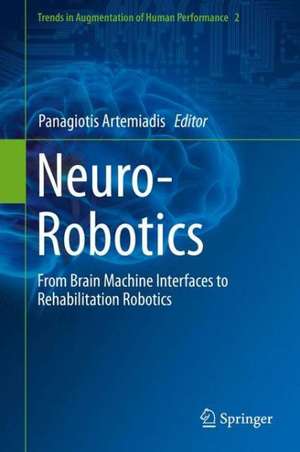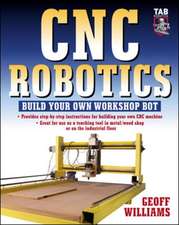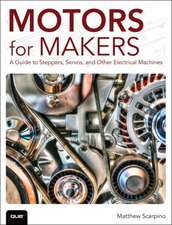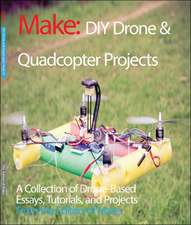Neuro-Robotics: From Brain Machine Interfaces to Rehabilitation Robotics: Trends in Augmentation of Human Performance, cartea 2
Editat de Panagiotis Artemiadisen Limba Engleză Hardback – 29 iul 2014
| Toate formatele și edițiile | Preț | Express |
|---|---|---|
| Paperback (1) | 1103.03 lei 6-8 săpt. | |
| SPRINGER NETHERLANDS – 27 sep 2016 | 1103.03 lei 6-8 săpt. | |
| Hardback (1) | 1299.44 lei 6-8 săpt. | |
| SPRINGER NETHERLANDS – 29 iul 2014 | 1299.44 lei 6-8 săpt. |
Preț: 1299.44 lei
Preț vechi: 1367.82 lei
-5% Nou
Puncte Express: 1949
Preț estimativ în valută:
248.73€ • 270.26$ • 209.07£
248.73€ • 270.26$ • 209.07£
Carte tipărită la comandă
Livrare economică 21 aprilie-05 mai
Preluare comenzi: 021 569.72.76
Specificații
ISBN-13: 9789401789318
ISBN-10: 9401789312
Pagini: 450
Ilustrații: VIII, 448 p. 185 illus., 126 illus. in color.
Dimensiuni: 155 x 235 x 30 mm
Greutate: 0.81 kg
Ediția:2014
Editura: SPRINGER NETHERLANDS
Colecția Springer
Seria Trends in Augmentation of Human Performance
Locul publicării:Dordrecht, Netherlands
ISBN-10: 9401789312
Pagini: 450
Ilustrații: VIII, 448 p. 185 illus., 126 illus. in color.
Dimensiuni: 155 x 235 x 30 mm
Greutate: 0.81 kg
Ediția:2014
Editura: SPRINGER NETHERLANDS
Colecția Springer
Seria Trends in Augmentation of Human Performance
Locul publicării:Dordrecht, Netherlands
Public țintă
ResearchCuprins
1 A Learning Scheme for EMG Based Interfaces: On Task Specificity in Motion Decoding Domain.- 2 State of the art and perspectives of ultrasound imaging as a human-machine interface.- 3 Considering limb impedance in the design and control of prosthetic devices.- 4 Multi-axis Capability for Powered Ankle-foot Prostheses.- 5 Mimicking human-like leg function in prosthetic limbs.- 6 Multi-directional dynamic mechanical impedance of the human ankle; a key to anthropomorphism in lower extremity assistive robots.- 7 Development of the Quantified Human.- 8 Optimal Neural Representations for Brain-Mediated Human-Robot Interactions.- 9 Assisted Computer Interaction for Users with Weak Upper Limb Motion.- 10 Robotic Systems for Gait Rehabilitation.- 11 Enhancing recovery of sensorimotor functions: the role of robot generated haptic feedback in the re-learning process.- 12 Robotic Assistance for Cerebellar Reaching.- 13 A Human Augmentation Approach to Gait Restoration.- 14 Home-based rehabilitation: enabling frequent and effective training.- 15 Unilateral and Bilateral Rehabilitation of the Upper Limb Following Stroke via an Exoskeleton.- Index.
Recenzii
“This book describes the state of the art at the interface of neuroscience and robotics. It is divided into three sections that can be read independently, but as a whole it gives an overview of neurorobotics, artificial intelligence, and brain plasticity. … The audience includes those involved in the emerging and robust field of neuroscience and in particular neurorobotics. … it is a go-to resource for clinicians wanting a more in-depth understanding of the development of motion systems.” (Deborah J. Gaebler-Spira, Doody's Book Reviews, May, 2015)
Textul de pe ultima copertă
Neuro-robotics is one of the most multidisciplinary fields of the last decades, fusing information and knowledge from neuroscience, engineering and computer science. This book focuses on the results from the strategic alliance between Neuroscience and Robotics that help the scientific community to better understand the brain as well as design robotic devices and algorithms for interfacing humans and robots. The first part of the book introduces the idea of neuro-robotics, by presenting state-of-the-art bio-inspired devices. The second part of the book focuses on human-machine interfaces for performance augmentation, which can seen as augmentation of abilities of healthy subjects or assistance in case of the mobility impaired. The third part of the book focuses on the inverse problem, i.e. how we can use robotic devices that physically interact with the human body, in order (a) to understand human motor control and (b) to provide therapy to neurologically impaired people or people with disabilities.
Caracteristici
Several chapters give a very precise and broad overview of the state-of-the-art, very useful for a researcher that is just starting to investigate the field Many chapters provide technical details for experiments that provide useful tips to the reader Many chapters include clinical data to help the reader appreciate the application of those technologies











